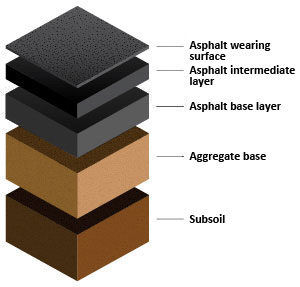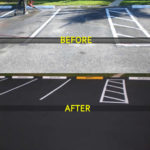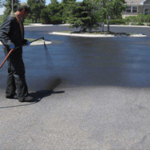Perpetual Pavement Method

Perpetual pavement means that pavement will be designed to withstand at least 50 years trafficking and no heavy (structural) maintenance will be required.A perpetual flexible pavement is defined as hot mix asphalt (HMA) pavement, designed and built to last longer than 50 years without requiring major structural rehabilitation or reconstruction. It may only need periodic surface renewal when the distresses have reached unacceptable levels. The design methods are currently used in the USA and other countries.
At the bottom of asphalt layers, at the place of tensile strain occurrence, so-called anti-fatigue course with high fatigue resistance, has to be designed. This minimizes the risk of fatigue cracking at the bottom of the pavement, which is one of the main structure failures.
Underneath the pavement surface, in the zone of high compression and shear stresses, the course with high resistance to deformation and resistance to low temperature cracking (depending on the climate) has to be designed.This will minimize the permanent deformation occurrence, such as rutting and risk of low-temperature cracking.
Perpetual Pavements have unintentionally been designed, constructed, and maintained for decades. Asphalt roads that were built decades ago have inadvertently become Perpetual as the lower lifts are still in place serving as the base while the surface has either been milled and replaced or had additional lifts added to it.
Perpetual Pavement Concept
The Perpetual Pavement concept was formally recognized in 2000 by the Asphalt Pavement Alliance (APA). At that time, it was recognized that many well-built, thick asphalt pavements that were categorized as either full-depth or deep-strength pavements had been in service for decades with only minor periodic surface rehabilitation to remove defects and improve ride quality.
In an effort to identify the pavement systems in service for the longest, APA defined criteria by which Perpetual Pavements from the past could be categorized and pavements of the future could be built to meet.
The Perpetual Pavement concept advances the notion that deep, structural pavement distresses that destroy pavement life could be altogether avoided if distresses were kept below the design threshold for strains, stresses, and deflections. In short, avoiding damage at the bottom or base of pavements and keeping wear at the surface level creates a system in which the initial road design remains in use indefinitely with only the top lift requiring maintenance. Building a base capable of such performance requires designing for the heaviest vehicle. This ensures the road is strong enough to resist stress and remain in sound structural condition. This design system not only creates quality roadways but is the most economical and financially responsible approach to infrastructure.
The approach to designing Perpetual Pavements is different than empirical methods which state the heavier volume of heavy loads, the thicker the pavement. Although Perpetual Pavements require a sound base, it does not simply mean designing thicker roadways on an abundance of stone. It means designing to reasonably withstand the heaviest load without over designing. Notably, while current design standards discourage overdesign, for many years, ‘the thicker the better’ was the mindset. These thick pavements unintentionally became the foundation of sixty year old perpetual pavements. By this it is known that over design is not necessary; the smart design is the ultimate goal.
Contact us
 Phone Call |
 Text Message |
 |







